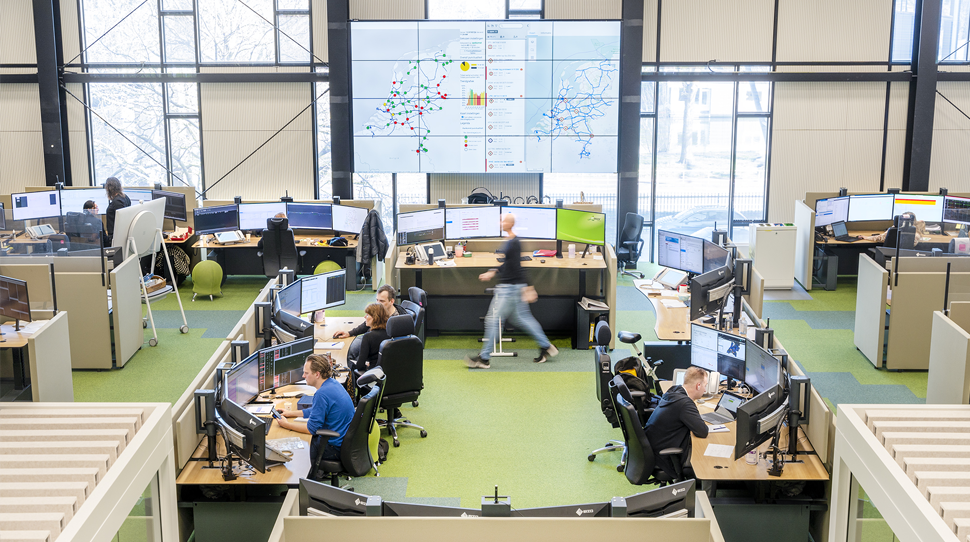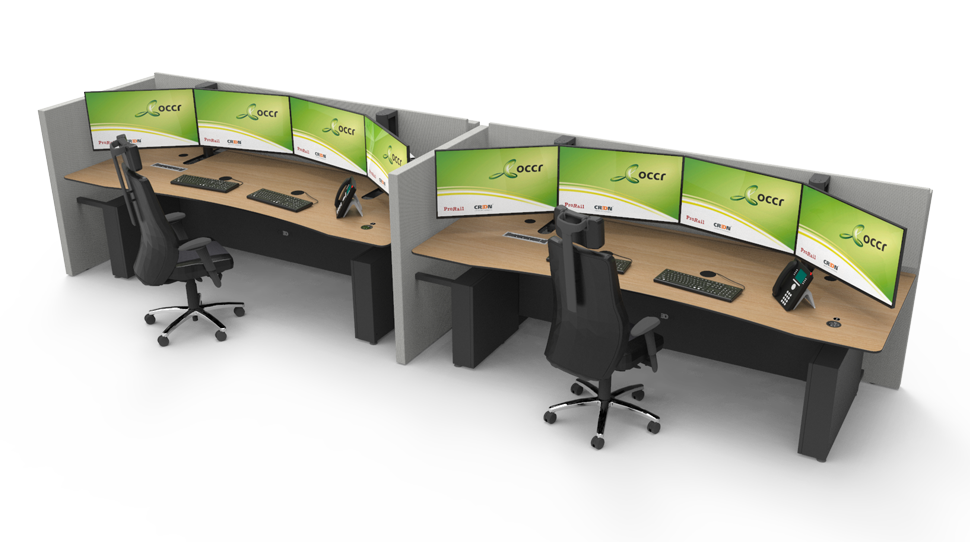Did you know that each day 4,000 to 4,500 train rides take place in the Netherlands to bring all passengers to their destinations? A lot of organization is involved to keep all trains running on time and to minimize any inconveniences. Many railway disciplines are involved in this process behind the scenes. Each discipline has its own objectives and interests. To optimize the collaboration, in October 2010 the Operational Control Center Rail (OCCR) was established ‘to prevent or minimize disruption to every rail user in the Netherlands’. From this central body the transport of people and goods over the railroad infrastructure is coordinated.
A dynamic 24-hour work environment
All parties that play a role in preventing or minimizing disruption on or around the railroad may rent a workplace at the OCCR. Taking part in this collective, where disciplines can quickly reach each other during an incident, provides the connection between all parties. Larger parties with a major contribution to the overall objective are occupying multiple workstations; smaller parties are often satisfied with one or two workstations. Parties may also choose to rent a workplace only temporarily. And yet other parties do not rent a workplace at the OCCR, they prefer to call in during meetings to be able to participate in discussions and decisions.
The OCCR building consists of several floors with different office spaces. Central to the building is the main hall. This is where many consultations take place between the various disciplines. The control island with the officers on duty and the process leaders is in the center of the hall. At the head is the Duty Officer for rail. The various disciplines are strategically placed around the control island. The complex setup of the room is well thought out so that closely cooperating parties can easily find each other in the space. The OCCR has a total of 100 operational workstations. There are several officers at each workstation, who alternate in shifts. Most workstations are manned 24/7.
The displacement principle determines which disciplines are or are not given a workstation: those who contribute the least to the overarching objective drop out first when there is a shortage of workplaces. Once a year, all applications for workstations at the OCCR are reviewed and a reshuffle takes place.
A major refresh
In 2020, the OCCR was in need of a major refresh. At least one representative from each discipline was invited to gather the wishes of his colleagues, with regard to the new desk, and represent their interests. This group included users, ICT administrators, facility managers and an ergonomist. Together with this user group, the entire requirements programme of requirements was drawn up. Next, the open European tender was issued. The supplier with the best bid was asked for a proof of concept. As a result of the Corona pandemic, the users were spread over two different locations. CREON then placed the proof of concept at two locations: in the OCCR and at the fallback location in ProRail’s main building. Based on a checklist, users checked the trial setup to see if all wishes and requirements had been met. CREON had made another suggestion list of minor adjustments to improve the workplace. Based on best value for money, CREON won the tender to deliver the 100 workstations for the main location and 20 workstations for the fallback location in the OCCR.
A customized solution
The 24-hour workstations by CREON were developed specifically for the OCCR, based on the requirements programme. Among other things, sufficient working space had to be taken into account when designing the workstations. The users requested four monitors next to each other, which should not overhang the worktop. Cables must be neatly concealed, and each workstation must have a single keyboard and mouse. The worktop should provide enough space for a telephone and if necessary a laptop. In addition to the sit-stand option, the monitors are also adjustable in height and depth. One unified solution was to be created: the OCCR desk.
During the installation of the workstations, the corona pandemic prevailed. A creative solution was found to minimize contact between the parties involved in the form of a so-called “train”. Electricians prepared the electrical and data connections. They were followed up by the flooring cutter. Then came the CREON mechanics to set up the 24-hour workstations. The ICT crew then came to flush the cables through the furniture and install the equipment, followed by the group that took care of further finishing and decorating the space. Finally, the users move into the workspaces. In this order, the train went through the entire building. This turned out to be a very efficient, streamlined approach.
No surprises
Marc Menkhorst was hired by the OCCR as a project leader and control room consultant to manage the renovation. He is very pleased with CREON. From the time of the contract award, he was in regular contact with CREON about planning and delivery because of the corona pandemic. “CREON didn’t actually manage to surprise me, but you should take that as a compliment. I already knew CREON from previous projects. My expectations were high and you guys met them.”
The renovated OCCR spaces are a big improvement over the old situation. The most noisy groups are now more shielded, partly because of the acoustic screens placed at the back of the workstations. These act as sound absorbers and they screen off the walking zones. Users find this very pleasant. The management is now located centrally in the room, so they are less bothered by people walking past behind them. As a result, there is more calmness.
Flexible, friendly and punctual
During the installation, Marc had a lot of contact with the CREON mechanics. “There was a nice contact with the Ronnies, Peters and Daves. They are very flexible, very friendly and very punctual. It was easy to interact with them. They work very neatly; when they are finished you don’t have any ‘mess’ in the room.”
Marc is also very pleased with the final result of the workstations. He describes the workstations as being functional and robust. ‘Functional’ because they do what they are supposed to and ‘robust’ because the desks can withstand rough handling. Due to their high quality, the furniture can easily last over a decade in a 24-hour environment. “They are beautiful desks, pleasant to work on, high-quality looking and have a sleek design.”







